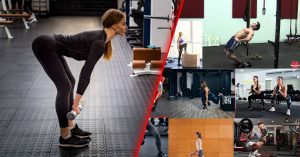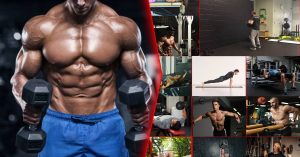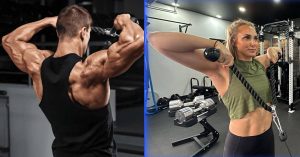Skip the biceps selfies, grab the groceries: Forget sculpted statues, this is real-world power. Functional strength training means mastering everyday movements, turning grocery bags into kettlebells and stairs into your new cardio playground.
We were born to move, not to exist in static poses and isolated machine workouts. Functional strength training taps into our body’s natural potential, mimicking the movements we use every day. It’s about rediscovering the symphony of power and coordination that lies within, letting your body move the way it was meant to – freely, powerfully, and with purpose.
This training is not just a fitness routine; it’s a return to the roots of human movement, blending strength, agility, and endurance in a way that benefits everyone from weekend warriors to professional athletes.
In this article I will guide you through everything you need to know about functional strength training, from what it is to different functional strength training exercises. So, stay tuned as I unveil the details.
Table of contents
MORE keyboard_double_arrow_down LESS keyboard_double_arrow_up
What is Functional Strength Training?
Functional strength training is a type of exercise that focuses on building strength to improve the performance of daily activities and movements. It involves performing exercises that mimic real-life movements and engage multiple muscle groups simultaneously.
This type of training emphasizes improving overall body functionality, stability, and mobility rather than just increasing muscle size or strength in isolation. Functional strength training often incorporates equipment such as resistance bands, kettlebells, medicine balls, and bodyweight exercises to simulate natural movements like pushing, pulling, lifting, and rotating.
The primary goal of functional strength training is to enhance an individual’s ability to perform activities of daily living with ease and efficiency while reducing the risk of injury. It can benefit people of all ages and fitness levels by improving balance, coordination, flexibility, and core strength.
Additionally, functional strength training is widely used in rehabilitation programs to help individuals regain strength and mobility after an injury or surgery.
Functional Strength Training vs Traditional Strength Training: What Makes it Stand Out?
Functional strength training, a stark contrast to traditional strength training, focuses on dynamic, multi-muscle exercises that mirror real-life activities. Instead of isolating muscles, this approach uses versatile equipment like kettlebells, dumbbells, bands, TRX, barbells, and bodyweight for comprehensive workouts that challenge the entire body in a functional manner.
Mayo Clinic praises functional strength training as a method to enhance life quality by easing everyday movements and reducing injury risks. A 2021 systematic review further underscored its impact on athletes’ performance, noting significant improvements in speed, strength, power, balance, and agility.
As a fitness professional with extensive experience in this field, and having personally embarked on a weight loss and muscle-building journey, I’ve seen firsthand the transformative power of functional strength training.
I’ve applied these methods successfully in training individuals aiming for weight loss and muscle gain, witnessing remarkable results. Further in this article, I’ll be sharing insights and exercises that have been most effective, combining my professional knowledge with personal experience. So, read on to find out!
Best Functional Strength Exercises
Mastering functional strength training begins with the essentials: everyday movements like squats, lunges, pushes, pulls, bends, and core control. These foundational exercises are not just the building blocks of functional fitness but also crucial for daily life activities.
Recommended Functional Strength Training Exercises For Beginners
For beginners, it’s important to start with the basics and perfect your form. Here’s how to perform some fundamental exercises:
Bodyweight Squat
Essential for lower body strength, the bodyweight squat involves standing with your feet shoulder-width apart, lowering your body as if sitting back into a chair, and then rising back up. Focus on keeping your back straight and knees in line with your feet.
90s Transition
This exercise enhances coordination and balance. Start in a squat position, and smoothly rise to a standing position, tightening your core and glutes at the top. Repeat this motion in a fluid, controlled manner.
Prisoner Get-Up
Ideal for leg strength and balance, start by kneeling. Step forward into a lunge and stand up, alternating legs. Keep your hands behind your head to engage the core further.
Jump Squat
Add an explosive element to the traditional squat by jumping up from the lowest squat position. This variation works on your power and cardiovascular endurance.
Jump Lunge
Perform a standard lunge, but add a jump to switch legs mid-air. This not only builds leg muscles but also improves agility and balance.
Lateral Lunge
Step out to the side into a deep lunge, targeting the inner thigh muscles. Return to the starting position and repeat on the other side. This exercise enhances lateral movement and flexibility.
Reverse Lunge
Step backward into a lunge, focusing on stability and glute strength. Reverse lunges are easier on the knees and great for improving posture.
Prone Swimmer
Lie face down and alternate lifting your arms and legs off the ground as if swimming. This exercise strengthens the back and improves overall flexibility.
Inchworm
A great full-body exercise that improves flexibility and core strength. Stand up straight, then bend at the waist and walk your hands forward into a plank position. Walk your hands back and stand up.
Palm Plan
A core-centric exercise, the Palm Plan is a variation of the plank where you balance on your palms and toes, keeping your body in a straight line. This exercise enhances core stability and strength.
Advancing Your Training
As you get stronger, consider adding more complex exercises, incorporating weights, and challenging yourself with combinations that engage multiple muscle groups. Remember, the key is to maintain correct form and controlled movements before increasing difficulty.
These exercises, when performed consistently and correctly, can significantly enhance your functional strength, preparing you for more advanced training and everyday life challenges.
Functional Strength Training Equipment
Functional strength training equipment plays a pivotal role in diversifying workouts and targeting different muscle groups effectively. Here’s how each piece of equipment can be utilized:
Jump Rope
A jump rope is a fantastic tool for cardiovascular conditioning. It enhances agility, coordination, and stamina. Used for warm-up or high-intensity interval training, it’s a staple in functional fitness for its simplicity and effectiveness in boosting heart rate.
Elastic Bands
Elastic bands offer resistance without the need for heavy weights. They are excellent for muscle toning and flexibility exercises. You can use them for resistance training, targeting both the upper and lower body, including exercises like band pulls, leg lifts, and more.
Pull-up Bar
The pull-up bar is essential for upper body strength, particularly for developing the back, shoulders, and arms. It can be used for a variety of exercises like pull-ups, chin-ups, and hanging leg raises, each of which strengthens different muscle groups.
Dumbbells
Dumbbells are incredibly versatile and can be used for a wide range of exercises, from bicep curls to shoulder presses, and even for adding weight to squats and lunges. They are perfect for targeting specific muscle groups and for compound movements.
Plyo Box
A plyo box is used primarily for plyometric exercises, which improve power, speed, and explosiveness. Exercises like box jumps, step-ups, and box squats are common, making it a valuable tool for enhancing lower body strength and agility.
Medicine Ball
Medicine balls are excellent for core workouts and coordination. They can be used for a variety of exercises, such as Russian twists, medicine ball slams, and wall balls. They add an element of resistance to core and full-body exercises.
Kettlebells
Kettlebells are fantastic for full-body workouts, combining strength, cardiovascular fitness, and flexibility. They can be used for exercises like kettlebell swings, Turkish get-ups, and goblet squats, each engaging multiple muscle groups in a dynamic way.
What Do Experts Say About Functional Strength Training?
Functional strength training has been recommended as a great workout method by many experts. They emphasize the practicality and real-life application of functional strength training, highlighting its importance beyond just physical appearance. Here are some direct insights from experts in the field:
Michael Boyle, Strength and Conditioning Coach states that “Functional training is about preparing your body for the demands of everyday life. It’s not just about looking good, it’s about being able to move with power, control, and grace. If you can squat, lunge, push, pull, and carry, you can do anything.”
Furthermore, Dr. Kelly Starrett, Physical Therapist and Author states: “Functional training is not about replicating specific sports movements, but rather about building a foundation of basic movement skills that can be applied to any activity.”
Lastly, take a look at this instagram post from James Pieratt – Hybrid Athlete & Bestselling Author, where he talks about Functional Strength Secrets of Ancient China and how it was used back in the day to build body strength:
Additional Advice And Tips for Effective Training
If you decide to pursue functional strength training, here are some tips and advice to keep in mind:
- Master the Movement Patterns: Focus on fundamental movements like squat, lunge, push, pull – perfect these with proper form before adding weight.
- Start Simple, Progress Gradually: Begin with bodyweight exercises and slowly introduce resistance as your strength builds. Avoid rushing into heavy weights.
- Everyday Movement is Your Gym: Incorporate functional movements into daily activities – do squats while cleaning, lunges with groceries, and planks while waiting in line.
- Find Your Fun: Keep your workouts varied by mixing different exercises and equipment. Enjoyment is key to maintaining motivation in your fitness journey.
- Listen to Your Body: Prioritize rest and recovery. If you experience pain, take a break and consider modifying exercises to suit your body’s needs.
Final Thoughts
Functional strength training is more than a fitness trend; it’s a lifestyle choice that enhances your daily life.
By embracing these exercises and equipment, you’re not just working towards a stronger physique but a more agile, efficient, and capable body prepared for whatever life throws your way.
So, are you ready to start your journey in functional strength training? Begin today and watch your body transform for the better.
Key Points
- Functional strength training focuses on dynamic, real-life movements.
- It uses versatile equipment for comprehensive workouts.
- Proven to improve daily functionality and reduce injury risks.
- Incorporates exercises like squats, lunges, and core strengthening.
- Emphasizes proper form and gradual progression.
- Suitable for all fitness levels, from beginners to advanced.
- Enhances speed, strength, power, balance, and agility.
- Adaptable to individual fitness goals and preferences.
- A holistic approach to fitness that goes beyond aesthetics.
FAQs
What makes functional strength training different?
It focuses on exercises that mimic everyday movements.
Can beginners do functional strength training?
Yes, start with basic movements and gradually increase difficulty.
Is special equipment required?
No, you can start with bodyweight exercises and simple equipment like dumbbells.
References and Citations
- Mayo Clinic: Functional Fitness: Is It Right For You?
- SYSTEMATIC REVIEW: Effect of Functional Training on Fitness

ABOUT THE AUTHOR
Follow Valen Steven for a dose of fitness enthusiasm, evidence-based advice, and a roadmap to achieving your health and wellness goals.
Subscribe to our Newsletter
Dive into a world of fitness and wellness with our exclusive newsletter! Sign up now and receive weekly power-packs of fitness wisdom




